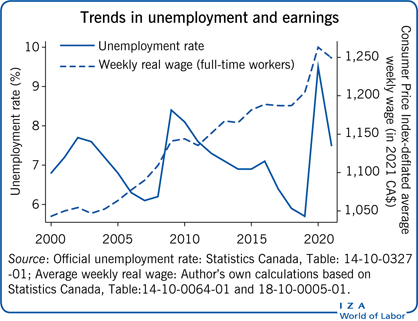Elevator pitch
From 2000 to 2019, Canada's economy and labor market performed well. Important in this success was a strong resource boom from the late 1990s to 2014. After the boom the economy and labor market adjusted relatively smoothly, with labor and other resources exiting resource-rich regions and moving elsewhere. Strong growth in major export markets (Asia and the US) aided the adjustment. The Covid-19 downturn resulted in an unprecedented decline in employment, and a steep rise in unemployment and non-participation. Despite the severity of the Covid-19 shock, by December 2021 most key measures of labor market activity had returned to pre-pandemic levels.

Key findings
Pros
Economic downturns during 2000–2019 were much less pronounced than during the 1980s and 1990s.
With the exception of the Covid-19 downturn, recent recessions in Canada have been much milder than in the US and much of Europe.
After rising markedly during the 1980s and 1990s, income inequality has been relatively stable since 2000 and declined a bit after 2008.
The male–female earnings gap has continued to decline, as have the earnings gaps between union and non-union workers and permanent and temporary/casual workers.
Cons
The end of the resource boom in 2014 required substantial labor reallocation due to job losses and unemployment in resource rich regions.
Real wage gains from 2000 to 2016 were modest in size—but nonetheless greater than during the preceding 20 years.
Real earnings gains were very unevenly shared in the 1980s, 1990s, and early 2000s, with especially large gains at the top of the wage distribution.
The labor market became polarized in terms of “good” (high-skill and high-paid) and “bad” jobs between 1970 and 2000, but has since stabilized.